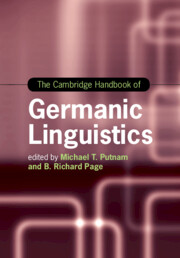Book contents
- The Cambridge Handbook of Germanic Linguistics
- Cambridge Handbooks in Language and Linguistics
- The Cambridge Handbook of Germanic Linguistics
- Copyright page
- Contents
- Figures
- Maps
- Tables
- Contributors
- Acknowledgments
- Germanic Languages
- Part I Phonology
- Part II Morphology and Agreement Systems
- Chapter 9 Verbal Inflectional Morphology in Germanic
- Chapter 10 Inflectional Morphology
- Chapter 11 Principles of Word Formation
- Chapter 12 Grammatical Gender in Modern Germanic Languages
- Chapter 13 Case in Germanic
- Chapter 14 Complementizer Agreement
- Part III Syntax
- Part IV Semantics and Pragmatics
- Part V Language Contact and Nonstandard Varieties
- Index
- References
Chapter 9 - Verbal Inflectional Morphology in Germanic
from Part II - Morphology and Agreement Systems
Published online by Cambridge University Press: 31 March 2020
- The Cambridge Handbook of Germanic Linguistics
- Cambridge Handbooks in Language and Linguistics
- The Cambridge Handbook of Germanic Linguistics
- Copyright page
- Contents
- Figures
- Maps
- Tables
- Contributors
- Acknowledgments
- Germanic Languages
- Part I Phonology
- Part II Morphology and Agreement Systems
- Chapter 9 Verbal Inflectional Morphology in Germanic
- Chapter 10 Inflectional Morphology
- Chapter 11 Principles of Word Formation
- Chapter 12 Grammatical Gender in Modern Germanic Languages
- Chapter 13 Case in Germanic
- Chapter 14 Complementizer Agreement
- Part III Syntax
- Part IV Semantics and Pragmatics
- Part V Language Contact and Nonstandard Varieties
- Index
- References
Summary
This chapter provides an overview of the morphosyntactic categories associated with the verb in Germanic and the various inflectional and periphrastic exponents of those categories, with a particular focus on inflectional classes. Characteristics common to most or all of the modern languages are emphasized, but important features of individual languages and branches are also described.
- Type
- Chapter
- Information
- The Cambridge Handbook of Germanic Linguistics , pp. 193 - 213Publisher: Cambridge University PressPrint publication year: 2020
References
- 1
- Cited by



